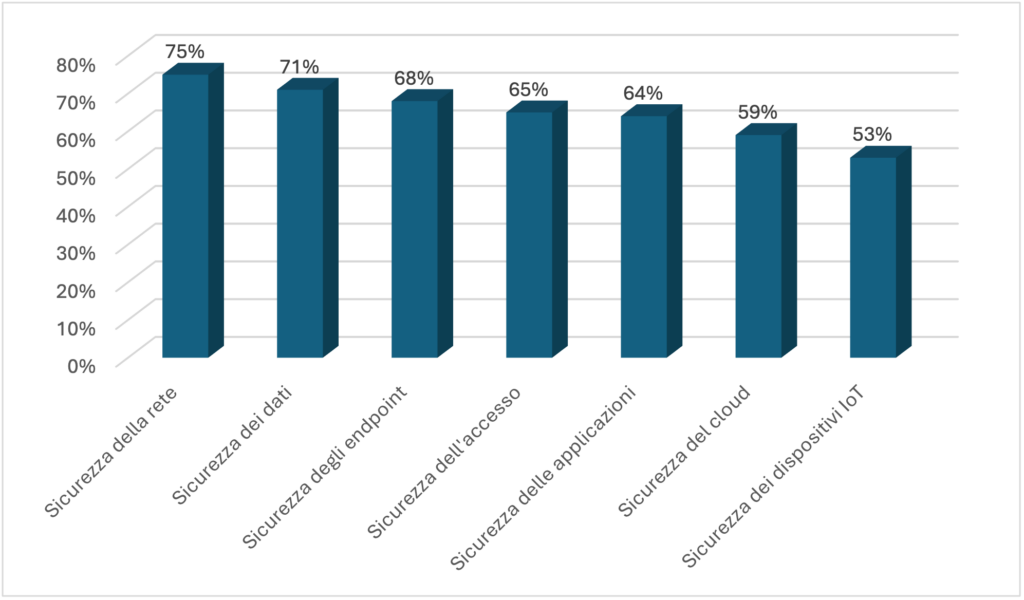- Mail:
- info@digital4pro.com
AI applicata alla cybersecurity: i vantaggi

IoT: Sicurezza e minacce nelle reti LoRaWAN
27 Agosto 2025
Il Service Climate: Cultura Organizzativa
9 Settembre 2025In questo appuntamento si descrivono i potenziali vantaggi apportati dall’intelligenza artificiale in termini di sicurezza informatica.
Come già osservato, questa tecnologia può essere impiegata per assicurare una protezione più efficace alle proprie strutture critiche nei confronti dei sempre più numerosi cyberattacchi. Essa rappresenta anche uno strumento utile per monitorare costantemente la sicurezza informatica dei propri dipendenti, che, soprattutto a causa della pandemia,hanno cominciato a lavorare sempre di più a distanza e quindi hanno maggiori probabilità di essere vittime di attacchi informatici.
Secondo l’ammiraglio Mike Rogers, direttore dell’agenzia di sicurezza nazionale degli Stati Uniti, l’intelligenza artificiale e il machine learning saranno fondamentali per il futuro della cybersecurity[1].
Questa prospettiva viene confermata dalle organizzazioni stesse. Infatti, secondo uno studio condotto[2] dalla società di consulenza Capgemini, circa il 66% delle aziende intervistate ritiene che questa tecnologia svolga un ruolo crucialenell’identificazione delle minacce informatiche a cui si è esposti. Inoltre, il 69% afferma che essa è fondamentale per rispondere in maniera tempestiva ed efficace ai cyberattacchi[3]. In seguito, si riporta un grafico che evidenzia iprincipali ambiti di applicazione dell’intelligenza artificiale in termini di cybersecurity all’interno delle organizzazioni.

Figura 1 – Principali aree in cui viene impiegata l’intelligenza artificiale per la cybersecurity [Fonte: https://www.capgemini.com/wp-content/uploads/2019/07/AI-in- Cybersecurity_Report_20190711_V06.pdf 2022/08/03].
Dai dati a disposizione, si nota che le principali aree in cui viene applicata l’intelligenza artificiale sono nell’ordine la sicurezza del network, dei dati e degli endpoint.
Dato che il network costituisce la colonna vertebrale di qualunque sistema basato sulla tecnologia dell’informazione,non è sorprendente vedere che la sua sicurezza si trova al primo posto.
Stessa cosa può essere detta per i dati, i quali sono sempre più numerosi perché prodotti costantemente dalle organizzazioni, e quindi possono rappresentare un obiettivo significativo per gli hacker.
Al terzo posto invece si trova la sicurezza degli endpoint, che ha lo scopo di proteggere i vari dispositivi utilizzatidall’utente finale, come computer, smartphone o tablet. Questo aspetto sta diventando sempre più importante, dato che, in seguito al fenomeno della digitalizzazione delle aziende, quasi tutti i dipendenti hanno in dotazione un dispositivo elettronico tramite cui connettersi a distanza al network aziendale.
Dopo aver stabilito che le organizzazioni stanno usufruendo progressivamente dell’intelligenza artificiale per potenziare i propri sistemi di sicurezza, si descrivono i principali meccanismi di difesa nei quali questa tecnologia puòessere impiegata[4]:
- Classificazione dei cyber-rischi: le macchine intelligenti sono in grado di attribuire in maniera autonoma un punteggio a ciascuno dei rischi a cui sono esposte le organizzazioni, basandosi sui dati quantitativi a disposizione. In questo modo, la classificazione viene determinata in termini data-driven e non secondo il giudizio personale degli esperti di sicurezza informatica;
- Monitoraggio continuo: ciò consente di tenere sotto controllo il comportamento degli utenti, in maniera tale da verificare se questi sono esposti o meno a Inoltre, in questo modo è possibile comprendere i loro modelli di comportamento e le loro abitudini quotidiane, al fine di riscontrare tempestivamente eventuali deviazioni rispetto agli standard. Ciò permette all’organizzazione di accorgersi rapidamente se qualcuno dei suoi dipendenti è stato vittima di phishing, oppure se qualcuno sta cercando di entrare nei server aziendali tramite account falsi. Infine, questa tecnica può essere sfruttata anche per identificare le aree più vulnerabiliall’interno del proprio network;
- Automatizzazione delle attività di sicurezza di routine: l’intelligenza artificiale è in grado di svolgere autonomamente alcune di queste attività ottenendo risultati di elevata qualità, in modo tale da consentire agli esperti di focalizzarsi sulle situazioni più critiche che richiedono necessariamente il giudizio umano;
- Rilevazione di malware e virus: le macchine intelligenti riescono a rilevare rapidamente le tracce o i segni di un software malevolo, grazie alla loro capacità di effettuare analisi in pochi secondi piuttosto che in alcune ore. In questo modo i cyberattacchi possono essere individuati e fronteggiati nel momento esatto in cuiavvengono[5]. Inoltre, gli algoritmi di machine learning offrono un vantaggio particolarmente significativo. Infatti, come già osservato, questi sono in grado di apprendere dall’esperienza passata. Di conseguenza, in base ai malware riscontrati in precedenza, sono in grado di prevedere con un buon livello di accuratezza quali saranno i virus che verranno sviluppati in futuro dagli hacker. In questo modo, le aziende hanno l’opportunità di prepararsi tempestivamente ad affrontare le minacce del futuro. In più, gli algoritmi, quando si trovano di fronte a un nuovo malware, sfruttando la base di dati di cui dispongono, riescono a ricondurre le sue caratteristiche principali ai virus fronteggiati in passato, al fine di determinare la tecnica più adatta per superare la criticità;
- Rilevazione delle intrusioni: l’intrusione può essere definita come “il tentativo di compromettere laconfidenzialità, l’integrità e la disponibilità di un computer o di un network, oppure come quello di aggirare i meccanismi di sicurezza di un computer o di un network[6]”. A tal proposito, l’intelligenza artificiale è capace diindividuare tempestivamente se un soggetto non autorizzato si è introdotto nei server Diconseguenza, le organizzazioni hanno la possibilità di realizzare dei sistemi per la rilevazione delle intrusionibasati su questa tecnologia, che possono rivelarsi particolarmente efficaci, visto che, secondo alcuni studi, hanno la capacità di rilevare tempestivamente le intrusioni con un’accuratezza che oscilla tra il 97 e il 99%[7];
- Rilevazione delle frodi: il machine learning può essere impiegato per rilevare le minacce di frodi, grazie alla possibilità di analizzare ogni tipo di transazione effettuata dall’organizzazione in tempo reale;
- Filtraggio delle e-mail: gli algoritmi di intelligenza artificiale possono essere utilizzati per classificare le e-mail ricevute in base ad alcune caratteristiche. In questo modo, tutte quelle e-mail che potenzialmente sono pericolose, perché contenenti virus, vengono inserite nella casella relativa alla posta
Occorre poi sottolineare che tutti gli interventi fin qui descritti vengono svolti in maniera autonoma e contemporaneamente rispetto alla normale operatività aziendale. Questo aspetto è particolarmente vantaggioso in quanto consente di fronteggiare e risolvere le problematiche di sicurezza informatica senza interrompere il normale flusso di attività delle imprese.
In seguito, si esaminano i potenziali principali benefici a livello organizzativo derivanti dall’adozione dell’intelligenza artificiale per la cybersecurity. Secondo la ricerca di Capgemini a cui si è già fatto riferimento[8], i vantaggi principalisono tre: la riduzione dei costi per rilevare e rispondere ai cyberattacchi, la maggiore tempestività nella reazione el’incremento dell’accuratezza nella rilevazione. Relativamente al primo beneficio, il 64% delle organizzazioni intervistate afferma che l’introduzione delle macchine intelligenti riduce i costi necessari per individuare e reagire alle violazioni della sicurezza informatica. Di seguito, si riporta una tabella che evidenzia l’ammontare percentuale di diminuzione delle spese riscontrato dalle organizzazioni intervistate.
| VALORE DELLARIDUZIONE DEI COSTI | COSTI PER RILEVAREUNA VIOLAZIONE | COSTI PER REAGIRE AUNA VIOLAZIONE |
| Diminuzione tra 1-15% | 48% | 42% |
| Diminuzione >15% | 10% | 17% |
Tabella 1 – Diminuzione dei costi per rilevare e reagire a un cyberattacco nelle organizzazioni intervistate da Capgemini[9].
I dati a disposizione evidenziano come nella maggior parte dei casi, sia per la rilevazione che la reazione alcyberattacco, la riduzione dei costi è compresa tra l’1 e il 15%. Inoltre, occorre sottolineare che l’impatto più significativo viene esercitato sui costi da sostenere per reagire a una violazione, dato che il livello percentuale di diminuzione superiore al 15% è maggiore rispetto a quello dei costi di rilevazione. Per quanto riguarda invece il secondo miglioramento, il 74% delle organizzazioni intervistate afferma che l’intelligenza artificiale consente di ridurre il tempo necessario per rispondere a un cyberattacco. A tal proposito si riporta la seguente tabella.
| VALORE DELLARIDUZIONE DEL TEMPO | TEMPO PER RILEVAREUNA VIOLAZIONE | TEMPO PER REAGIRE AUNA VIOLAZIONE |
| Diminuzione tra 1-15% | 46% | 43% |
| Diminuzione >15% | 13% | 16% |
Tabella 2 – Diminuzione delle tempistiche per rilevare e reagire a un cyberattacco nelle organizzazioni intervistate da Capgemini[10].
Anche in questo caso, si nota che nella maggior parte dei casi la riduzione delle tempistiche è compresa tra l’1 e il15%. In più, ancora una volta l’impatto più significativo si verifica sull’operazione di reazione al cyberattacco. Infine, relativamente al terzo vantaggio, il 69% delle organizzazioni intervistate afferma che l’impiego dell’intelligenzaartificiale migliora l’accuratezza nella fase di rilevazione dei cyberattacchi.
Conclusioni
A livello complessivo, si può quindi affermare che l’intelligenza artificiale svolge un ruolo fondamentale in termini di cybersecurity. Attualmente, come già osservato, essa viene impiegata in alcuni ambiti della sicurezza informatica e secondo gli esperti, il suo utilizzo è destinato a crescere progressivamente. Nello specifico, essa può essere considerata come una sorta di guardiano sempre attivo all’interno delle organizzazioni, in grado di massimizzare l’efficienza e la tempestività nell’individuazione degli eventi di cybersecurity che interessano le aziende. Ciò viene confermato anche dalla ricerca di Capgemini, secondo cui le imprese impiegano le macchine intelligenti prevalentemente nella fase di rilevazione delle minacce e dei rischi[11]. Tuttavia, occorre sottolineare che per conseguire i vantaggi fin qui descritti, le imprese devono investire in misura significativa. Inoltre, è necessario molto tempo prima che queste innovazioni riescano a rendere al massimo delle proprie possibilità. Infine, vi è anche il rischioche gli stessi hacker impieghino l’intelligenza artificiale per effettuare i cyberattacchi e che magari le tecnologie daquesti utilizzate siano più avanzate rispetto a quelle adottate dalle organizzazioni. A tal proposito, è interessante riportare l’esempio di alcune organizzazioni che hanno sviluppato delle piattaforme di sicurezza basate sull’intelligenza artificiale per fronteggiare le minacce più avanzate. Questi sistemi sono stati creati attraverso una combinazione tra algoritmi euristici e di machine learning per fornire capacità come la generazione di antivirus, l’analisi comportamentale degli utenti e la difesa da attacchi mirati. I risultati ottenuti hanno evidenziato che queste tecniche sono molto efficaci nei confronti degli attacchi informatici guidati da hacker umani, mentre si sono mostrate vulnerabili nei confronti dei cyberattacchi basati sull’intelligenza artificiale[12]. Nonostante ciò, occorre ribadire che questa tecnologia è caratterizzata da una rapida evoluzione, per cui è possibile che nel futuro vengano sviluppati sistemi in grado di rintracciare e fronteggiare adeguatamente anche questa forma di attacco informatico.
Bibliografia
- Agrawal, A., Gans, J., & Goldfarb, A. (2017). The trade-off every AI company will face.
- Harvard Business Review Digital Articles.
- Aspan, M. (2020). Siri, Did I Ace the Interview? Fortune International (Europe), 181(2).
- Bhimani, A., & Willcocks, L. (2014). Digitisation, Big Data and the transformation of accounting information. Accounting and Business Research, Taylor & Francis, Vol. 44 No. 4.
- Brundage, M., Avin, S., Clark, J., Toner, H., Eckersley, P., Garfinkel, B., … & Amodei, D. (2018). The malicious use of artificial intelligence: Forecasting, prevention, and mitigation. arXiv preprint arXiv:1802.07228.
- CGMA (2016). Business Analytics And Decision Making. Baseline.
- Costa, G., & Gianecchini, M. (2019). Risorse umane: persone, relazioni e valore (Vol. 454). McGraw-Hill.
- Craigen, D., Diakun-Thibault, N., & Purse, R. (2014). Defining cybersecurity. Technology Innovation Management Review, 4(10).
- Daft, R. L. (2017). Organizzazione aziendale. Sesta edizione. Daft, R. L. (2021). Organizzazione aziendale. Maggioli, Milano.
- Davenport, T., Guha, A., & Grewal, D. (2021). How to Design an AI Marketing Strategy: What the Technology Can Do Today—and What’s Next. Harvard Business Review, 99, 42- 47.
- Davenport, T., Guha, A., Grewal, D., & Bressgott, T. (2020). How artificial intelligence will change the future of marketing. Journal of the Academy of Marketing Science, 48(1), 24- 42.
- Doke, D. (2021). Software AI. Recruiter.
- Forger, G. (2020). AI and IoT are ready for your warehouse. Logistics management (Highlands Ranch, Colo.: 2002).
- Fountaine, T., McCarthy, B., & Saleh, T. (2021). Getting AI to scale. Harvard Business Review.
- Galeotti, M., & Garzella, S. (Eds.). (2013). Governo strategico dell’azienda: Prefazione del Prof. Umberto Bertini. G Giappichelli Editore.
- Gambhir, B., & Bhattacharjee, A. (2021). Embracing the role of artificial intelligence in accounting and finance: contemplating the changing skillset expectations. Development and Learning in Organizations: An International Journal.
- Gregg, M. (2005). CISSP security-management practices. Upper Saddle River, NJ: Pearson Education.
- Haenlein, M., & Kaplan, A. (2019). A brief history of artificial intelligence: On the past, present, and future of artificial intelligence. California management review, 61(4), 5-14.
- Harrison, N., & O’Neill, D. (2017). If your company isn’t good at analytics, it’s not ready for AI. Harvard Business Review.
- Henke, N., Levine, J., & McInerney, P. (2018). You don’t have to be a data scientist to fill this must-have analytics role. Harvard Business Review.
- Huang, M. H., Rust, R., & Maksimovic, V. (2019). The feeling economy: Managing in the next generation of artificial intelligence (AI). California Management Review, 61(4), 43-65.
- Lichtenthaler, U. (2020). Mixing data analytics with intuition: Liverpool Football Club scores with integrated intelligence. Journal of Business Strategy.
- Luo, X., Qin, M. S., Fang, Z., & Qu, Z. (2021). Artificial intelligence coaches for sales agents: Caveats and solutions. Journal of Marketing, 85(2), 14-32.
- McAfee, A., & Brynjolfsson, E. (2012). Big data: the management revolution. Harvard business review, 90(10), 60-68.
- Miyashita, M., & Brady, M. (2019). The Health Care Benefits of Combining Wearables and AI. Harvard Business Review.
- Nair, K., & Gupta, R. (2021). Application of AI technology in modern digital marketing environment. World Journal of Entrepreneurship, Management and Sustainable Development.
- Niehueser, W., & Boak, G. (2020). Introducing artificial intelligence into a human resources function. Industrial and commercial training, 52(2), 121-130.
- Ore, O., & Sposato, M. (2021). Opportunities and risks of artificial intelligence in recruitment and selection. International Journal of Organizational Analysis.
- Paschen, J., Kietzmann, J., & Kietzmann, T. C. (2019). Artificial intelligence (AI) and its implications for market knowledge in B2B marketing. Journal of Business & Industrial Marketing.
- Paschen, U., Pitt, C., & Kietzmann, J. (2020). Artificial intelligence: Building blocks and an innovation typology. Business Horizons, 63(2), 147-155.
- Petkov, R. (2020). Artificial intelligence (AI) and the accounting function—A revisit and a new perspective for developing framework. Journal of emerging technologies in accounting, 17(1), 99-105.
- Pighin, M., & Marzona, A. (2018). Sistemi informativi aziendali: ERP e sistemi di data analysis.
- Poba-Nzaou, P., Galani, M., Uwizeyemungu, S., & Ceric, A. (2021). The impacts of artificial intelligence (AI) on jobs: an industry perspective. Strategic HR Review, 20(2), 60- 65.
- Ponnapalli, P. (2022). Keys to successful innovation through artificial intelligence. Harvard Business Review.
- Ransbotham, S., Candelon, F., Kiron, D., LaFountain, B., & Khodabandeh, S. (2021). The Cultural Benefits of Artificial Intelligence in the Enterprise. MIT Sloan Management Review and Boston Consulting Group.
- Rudko, I., Bashirpour Bonab, A., & Bellini, F. (2021). Organizational structure and artificial intelligence. Modeling the intraorganizational response to the ai contingency. Journal of Theoretical and Applied Electronic Commerce Research, 16(6), 2341-2364.
- Samonas, S., & Coss, D. (2014). The CIA strikes back: Redefining confidentiality, integrity and availability in security. Journal of Information System Security, 10(3).
- Shrestha, Y. R., Ben-Menahem, S. M., & Von Krogh, G. (2019). Organizational decision- making structures in the age of artificial intelligence. California Management
- Review, 61(4), 66-83.
- Simonovich, L. (2021). Balancing AI advances with robust cybersecurity solutions. World Oil.
- Soni, V. D. (2020). Challenges and Solution for Artificial Intelligence in Cybersecurity of the USA. Available at SSRN 3624487.
- Strubell, E., Ganesh, A., & McCallum, A. (2019). Energy and policy considerations for deep learning in NLP. arXiv preprint arXiv:1906.02243.
- Tabesh, P. (2021). Who’s making the decisions? How managers can harness artificial intelligence and remain in charge. Journal of Business Strategy.
- S (2021). 3 areas where AI will boost your competitive advantage. Harvard Business Review Digital Articles.
- Truong, T. C., Zelinka, I., Plucar, J., Čandík, M., & Šulc, V. (2020). Artificial intelligence and cybersecurity: Past, presence, and future. In Artificial intelligence and evolutionary computations in engineering systems (pp. 351-363). Springer, Singapore.
- Tschang, F. T., & Almirall, E. (2021). Artificial intelligence as augmenting automation: Implications for employment. Academy of Management Perspectives, 35(4), 642-659.
- Tse, T., Esposito, M., Takaaki, M., & Goh, D. (2020). The dumb reason your AI project will fail. Harvard business review digital articles, 2-5.
- Vadari, S., & Desik, P. A. (2021). The Role of AI/ML in Enhancing Knowledge Management Systems. IUP Journal of Knowledge Management, 19(2), 7-31.
- Wamba-Taguimdje, S. L., Wamba, S. F., Kamdjoug, J. R. K., & Wanko, C. E. T. (2020). Influence of artificial intelligence (AI) on firm performance: the business value of AI-based transformation projects. Business Process Management Journal, 26(7), 1893-1924.
- Whitmore, A., Agarwal, A., & Da Xu, L. (2015). The Internet of Things—A survey of topics and trends. Information systems frontiers, 17(2), 261-274.
- Yampolskiy, R. V. (2017). AI Is the Future of Cybersecurity, for Better and for Worse. Harvard Business Review. May, 8.
- Zaki, M., McColl-Kennedy, R., & Neely, A. (2021). Using AI to Track How Customers Feel—In Real Time. Harvard Business Review.
- Zhang, H., Zhang, X., & Song, M. (2021). Deploying AI for New Product Development Success: By embracing and incorporating AI in all stages of NPD, companies can increase their success rate of NPD projects. Research-Technology Management, 64(5), 50-57.
- Zouave, E., Gustafsson, T., Bruce, M., Colde, K., Jaitner, M., & Rodhe, I. (2020). Artificially intelligent cyberattacks. Swedish Defence Research Agency, FOI, Tech. Rep. FOI.
- (2017). Lavazza a caccia di “coffe addicted” con l’intelligenza artificiale. Il Sole 24 Ore. Retrieved fromhttps://www.ilsole24ore.com/art/lavazza-caccia-coffee-addicted-l- intelligenza-artificiale–AEBRpxQD 2022/08/02
- Amar, J., Majumder, S., Surak, Z., & von Bismarck, N. (2021). How AI-driven nudges can transform an operation’s performance. McKinsey Global Institute. Retrieved from https://www.mckinsey.com/business-functions/operations/our-insights/how-ai-driven- nudges-can-transform-an-operations-performance 2022/07/27
- Balabio, B., Orlando, P., & Scolari, T. (2021). Cresce il mercato dell’intelligenza artificiale in Italia. Retrieved from https://www.osservatori.net/it/ricerche/comunicati- stampa/artificial-intelligence-italia-mercato-progetti-20202022/07/08
- Berruti, F., Nel, P., & Whiteman R. (2020). An executive primer on artificial general intelligence. McKinsey Global Institute. Retrieved from https://www.mckinsey.com/business-functions/operations/our-insights/an-executive- primer-on-artificial-general-intelligence 2022/07/06
- Boehm, J., Curcio, N., Merrath, P., Shenton, L., & Stahle T. (2019). The risk-based approach to cybersecurity. McKinsey Global Institute. Retrieved from https://www.mckinsey.com/business-functions/risk-and-resilience/our-insights/the-risk- based-approach-to-cybersecurity 2022/08/03
- Brooks, C. (2022). Alarming cyber statistics for mid-year 2022 that you need to know. Forbes. Retrieved from https://www.forbes.com/sites/chuckbrooks/2022/06/03/alarming- cyber-statistics-for-mid-year-2022-that-you-need-to-know/?sh=7043d0247864 2022/08/03
- Brown, S., Gandhi, D., Herring, L., & Puri, A. (2019). The analytics academy: bridging the gap between human and artificial intelligence. McKinsey Global Institute. Retrieved from https://www.mckinsey.com/business-functions/mckinsey-analytics/our-insights/the- analytics-academy-bridging-the-gap-between-human-and-artificial-intelligence 2022/07/18
- Buehler, K., Dooley, R., Grennan, L., & Singla, A. (2021). Getting to know-and manage- your biggest AI risks. McKinsey Global Institute. Retrieved from https://www.mckinsey.com/business-functions/mckinsey-analytics/our-insights/getting-to- know-and-manage-your-biggest-ai-risks 2022/07/11
- Bughin, J., Seong, J., Manyika, J., Chui, M., & Joshi, R. (2018). Notes from the AI frontier: Modeling the impact of AI on the world economy. McKinsey Global Institute. Retrieved from https://www.mckinsey.com/featured-insights/artificial-intelligence/notes-from-the-ai- frontier-modeling-the-impact-of-ai-on-the-world-economy#part12022/07/15
- Chakraborty, A. (2021). A.I. can be a cornerstone of success – but only if leaders make the right choices. Fortune. Retrieved from https://fortune.com/2021/10/27/ai-artificial- intelligence-business-strategy-data-accenture/2022/07/29
- Chui, M., Hall, B., Singla, A., & Sukharevsky, A. (2021). The state of AI in 2021. McKinsey Global Institute. Retrieved from https://www.mckinsey.com/business- functions/quantumblack/our-insights/global-survey-the-state-of-ai-in-20212022/07/08
- Chui, M., Manyika, J., Miremadi, M., Henke, N., Chung, R., Nel, P., & Malhotra, S. (2018). Notes from the AI frontier: Applications and value of deep learning. McKinsey global institute discussion paper, April. Retrieved from https://www.mckinsey.com/featured- insights/artificial-intelligence/notes-from-the-ai-frontier-applications-and-value-of-deep- learning 2022/07/07
- Dandona, G. S., Sharma, J., & Wright, M. (2021). Our own digital journey: upskilling hundreds of McKinsey technologists in AI. McKinsey Global Institute. Retrieved from https://www.mckinsey.com/about-us/new-at-mckinsey-blog/ai-upskilling-for-over-500- firm-technologists 2022/07/19
- Fowler, G. (2020). AI and its potential for cybersecurity. Forbes. Retrieved from https://www.forbes.com/sites/forbesbusinessdevelopmentcouncil/2020/12/18/ai-and-its- potential-for-cybersecurity/?sh=5d2f609e69d9 2022/08/03
- https://assets.siemens-energy.com/siemens/assets/api/uuid:cf20f2e1-ca9c-4589-9f88- 4e6592b4672d/brochure-deeparmour-industrial-200609.pdf 2022/08/05
- https://bids.berkeley.edu/news/berkeley-institute-data-science-and-accenture-applied- intelligence-announce-new-collaboration 2022/07/18
- https://info.algorithmia.com/hubfs/2020/Reports/2021-Trends-in- ML/Algorithmia_2021_enterprise_ML_trends.pdf?hsLang=en-us 2022/07/08
- https://wwd.com/business-news/technology/levis-ai-bootcamp-data-science-1234881378/ 22/09/04
- https://www.accenture.com/_acnmedia/PDF-63/Accenture-CoBE-Brochure-
- pdf#zoom=50 2022/08/23
- https://www.accenture.com/fr-fr/_acnmedia/36dc7f76eab444cab6a7f44017cc3997.pdf 2022/07/08
- https://www.bcg.com/publications/2020/is-your-company-embracing-full-potential-of- artificial-intelligence 2022/09/17
- https://www.capgemini.com/wp-content/uploads/2019/07/AI-in- pdf 2022/08/03
- https://www.careers.ox.ac.uk/article/the-pymetrics-games-overview-and-practice- guidelines 2022/07/26
- https://www.cnr.it/sites/default/files/public/media/attivita/editoria/VOLUME%20FULL%20 14%20digital%20LIGHT.pdf 2022/08/22
- https://www.levistrauss.com/2021/05/17/machine-learning-bootcamp/ 2022/07/19
- https://www.linkedin.com/pulse/how-coca-cola-using-ai-stay-top-soft-drinks-market- shivani-salunkhe 2022/08/23
- https://www.mckinsey.com/about-us/new-at-mckinsey-blog/mckinsey-receives-top- ranking-in-the-forrester-wave-ai-report 2022/07/19
- https://www.nist.gov/system/files/documents/cyberframework/cybersecurity-framework- pdf 2022/08/03
- https://www.statista.com/statistics/1083482/worldwide-ai-revenue-increase/ 2022/08/02 https://www.statista.com/statistics/1083516/worldwide-ai-cost-decrease/ 2022/08/02
- https://www.statista.com/statistics/1119824/global-business-and-hr-leaders-on-ai-impact- to-job-numbers/ 2022/07/20
- https://www.statista.com/statistics/1235395/worldwide-ai-enabled-cyberattacks- companies/ 2022/08/05
- https://www.statista.com/statistics/1293758/ai-marketing-revenue-worldwide/ 2022/07/25
- https://www.statista.com/statistics/472934/business-analytics-software-revenue- worldwide/ 2022/07/29
- https://www.statista.com/statistics/871513/worldwide-data-created/ 2022/07/29
- https://www.statista.com/statistics/941137/ai-investment-and-funding-worldwide/ 2022/07/08
- https://www.treccani.it/enciclopedia/intelligenza-artificiale 2022/07/04
- https://www.treccani.it/enciclopedia/sicurezza-informatica/#:~:text=sicur%C3%A9zza%20inform%C3%A0tica%20Ramo%20dell’informatica,dati%20riservati%20in%20essi%20contenuti. 2022/09/13
- https://www.tripwire.com/state-of-security/security-data-protection/43-billion-stolen- through-business-email-compromise-since-2016-reports-fbi/ 2022/09/13
- https://www.webfx.com/martech/pricing/ai/#:~:text=In%202020%2C%20companies%20can%20pay,house%20or%20freelance%20data%20scientists.&text=In%20comparison
- %2C%20custom%20AI%20solutions,from%20%246000%20to%20over%20%24300%2C 000. 2022/09/18
- Jeans, D. (2020). Companies will spend $50 billion on artificial intelligence this year with little to show for it. Forbes. Retrieved from https://www.forbes.com/sites/davidjeans/2020/10/20/bcg-mit-report-shows-companies- will-spend-50-billion-on-artificial-intelligence-with-few-results/?sh=7efe3fe57c87 2022/09/17
- Johar, P. (2020). How AI makes big data smarter. Forbes. Retrieved from https://www.forbes.com/sites/forbestechcouncil/2020/03/23/how-ai-makes-big-data- smarter/?sh=381f9b6a4684 2022/08/01
- Luchtenberg, D., & Migliorini, R. (2022). Coca-Cola: The people-first story of a digital transformation. McKinsey Global Institute. Retrieved from https://www.mckinsey.com/business-functions/operations/our-insights/coca-cola-the-people-first-story-of-a-digital-transformation 2022/08/02
- Malins, A. (2022). Machine learning and artificial intelligence: implementation in practice. Forbes. Retrieved from https://www.forbes.com/sites/forbestechcouncil/2022/01/25/machine-learning-and- artificial-intelligence-implementation-in-practice/?sh=7692b2a35c89 2022/07/15
- Manyika J., & Sneader K. (2018). AI, automation, and the future of work: Ten things to solve for. McKinsey Global Institute. Retrieved from https://www.mckinsey.com/featured- insights/future-of-work/ai-automation-and-the-future-of-work-ten-things-to-solve-for 2022/07/15
- Marr, B. (2017). The Amazing Ways Coca Cola Uses Artificial Intelligence And Big Data To Drive Success. Forbes. Retrieved from https://www.forbes.com/sites/bernardmarr/2017/09/18/the-amazing-ways-coca-cola- uses-artificial-intelligence-ai-and-big-data-to-drive-success/?sh=1448c01778d2 2022/08/02
- Marr, B. (2018). The amazing ways how Unilever uses artificial intelligence to recruit & train thousands of employees. Forbes. Retrieved from https://www.forbes.com/sites/bernardmarr/2018/12/14/the-amazing-ways-how-unilever-uses-artificial-intelligence-to-recruit-train-thousands-of-employees/?sh=485a1ca76274 2022/07/26
- Marr, B. (2022). The most in – demand technical skills – and how to develop them. Forbes. Retrieved from https://www.forbes.com/sites/bernardmarr/2022/08/03/the-most- in-demand-technical-skills–and-how-to-develop-them/?sh=7a1c4e1362e4 2022/08/22
- Mohan S. (2022). How to make it easier to implement AI in your business. Forbes. Retrieved from https://www.forbes.com/sites/forbestechcouncil/2022/05/27/how-to- make-it-easier-to-implement-ai-in-your-business/?sh=481bfbd65300 2022/07/12
- Rossitto, S. (2021). “Senza intelligenza artificiale e big data impossibile un vaccino contro il Covid in tempi brevi”. Il Sole 24 Ore. Retrieved from https://www.ilsole24ore.com/art/senza-intelligenza-artificiale-e-big-data-impossibile-vaccino-contro-covid-tempi-brevi-AD5lOYHB 2022/08/01
- Rusconi, G. (2022). L’intelligenza artificiale facilita il cambiamento organizzativo. Il Sole 24 Ore. Retrieved from https://www.ilsole24ore.com/art/l-intelligenza-artificiale-facilita- cambiamento-organizzativo-AEitC2OB 2022/07/14
- Sinur, J., & Peters, E. (2019). AI & big data; better together. Forbes. Retrieved from https://www.forbes.com/sites/cognitiveworld/2019/09/30/ai-big-data-better- together/?sh=61a9e9a360b3 2022/08/01
- Taulli, T. (2021). Artificial intelligence: should you teach it to your employees? Forbes. Retrieved from https://www.forbes.com/sites/tomtaulli/2021/09/10/ai-artificial- intelligence-should-you-teach-it-to-your-employees/?sh=2bab6b507b73 2022/07/18
- Tremolada, L. (2019). Machine learning, deep learning e reti neurali. Ecco di cosa parliamo. Il sole 24 ore. Retrieved from https://www.ilsole24ore.com/art/machine- learning-deep-learning-e-reti-neurali-ecco-cosa-parliamo–AEaToEBH2022/07/07
- ASIMOV, I. (1950), I, Robot. (Cited at page 5)
- BABBAGE, C. (1982), «On the Mathematical Powers of the Calculating Engine», The Origins of Digital Computers. Texts and Monographs in Computer Science.
- BODEN, M. A. (2018), Artificial Intelligence: A Very Short Introduction.
- CAMPBELL, M., HOANE, A. J. e HSIUNG HSU, F. (2002), «Deep Blue», Artificial Intelligence, vol. 134, p. 57–83.
- CLARKE, A. C. e KUBRICK, S. (1968), 2001: A Space Odyssey.
- DICK, P. K. (1968), Do Androids Dream of Electric Sheep?
- HASHEMIPOUR, S. e ALI, M. (2020), «Amazon Web Services (AWS) – An Overview of the On-Demand Cloud Computing Platform».
- KRIZHEVSKY, A., SUTSKEVER, I. e HINTON, G. E. (2012), «ImageNet classification with deep convolutional neural networks», Communications of the ACM, vol. 60, p. 84 – 90.
- LECUN, Y., BENGIO, Y. e HINTON, G. E. (2015), «Deep Learning», Nature, vol. 521, p. 436–444.
- MASLEJ, N., FATTORINI, L., BRYNJOLFSSON, E., ETCHEMENDY, J., LIGETT, K., LYONS, T., MANYIKA, J., NGO, H., NIEBLES, J. C., PARLI, V., SHOHAM, Y., WALD, R., CLARK, J., e PERRAULT, R. (2023), «The AI Index 2023 Annual Report», Rap. tecn., AI Index Steering Committee, Institute for Human-Centered AI, Stanford University, Stanford, CA.
- MCCARTHY, J. (1960), «Programs with common sense».
- MCCARTHY, J., MINSKY, M., ROCHESTER, N. e SHANNON, C. E. (2006), «A Proposal for the Dartmouth Summer Research Project on Artificial Intelligence, August 31, 1955», AI Mag., vol. 27, p. 12–14.
- RAO, A. S. e VERWEIJ, G. (2017), «Sizing the prize: what’s the real value of AI for your business and how can you capitalise?».
- RUSSELL, B. e WHITEHEAD, A. N. (1956), «Principia Mathematica to *56».
- RUSSELL, S. e NORVIG, P. (1995), «Artificial intelligence – a modern approach: the intelligent agent book».
- TURING, A. (1937), «On computable numbers, with an application to the Entscheidungsproblem», Proc. London Math. Soc.
- VASWANI, A., SHAZEER, N. M., PARMAR, N., USZKOREIT, J., JONES, L., GOMEZ, A. N., KAISER, L. e POLOSUKHIN, I. (2017), «Attention is All you Need», in «NIPS».
Note
[1] Brundage, M., Avin, S., Clark, J., Toner, H., Eckersley, P., Garfinkel, B., … & Amodei, D. (2018), op. cit., 32.
[2] https://www.capgemini.com/wp-content/uploads/2019/07/AI-in- Cybersecurity_Report_20190711_V06.pdf 2022/08/03.
[3] Fowler, G. (2020). AI and its potential for cybersecurity. Forbes. Retrieved fromhttps://www.forbes.com/sites/forbesbusinessdevelopmentcouncil/2020/12/18/ai-and-its-potential-for- cybersecurity/?sh=5d2f609e69d92022/08/03.
[4] Fowler, G. (2020), op. cit.
[5] Soni, V. D. (2020). Challenges and Solution for Artificial Intelligence in Cybersecurity of the USA. Available at SSRN 3624487, 10.
[6] Truong, T. C., Zelinka, I., Plucar, J., Čandík, M., & Šulc, V. (2020). Artificial intelligence and cybersecurity:
Past, presence, and future. In Artificial intelligence and evolutionary computations in engineering systems (pp. 351-363).Springer, Singapore, 355.
[7] Truong, T. C., Zelinka, I., Plucar, J., Čandík, M., & Šulc, V. (2020), op. cit., 356.
[8] https://www.capgemini.com/wp-content/uploads/2019/07/AI-in- Cybersecurity_Report_20190711_V06.pdf 2022/08/03.
[9] https://www.capgemini.com/wp-content/uploads/2019/07/AI-in- Cybersecurity_Report_20190711_V06.pdf 2022/08/03.
[10] https://www.capgemini.com/wp- content/uploads/2019/07/AI-in-Cybersecurity_Report_20190711_V06.pdf 2022/08/03.
[11] https://www.capgemini.com/wp-content/uploads/2019/07/AI-in- Cybersecurity_Report_20190711_V06.pdf 2022/08/03.
[12] Brundage, M., Avin, S., Clark, J., Toner, H., Eckersley, P., Garfinkel, B., … & Amodei, D. (2018), op. cit., 33- 34.




